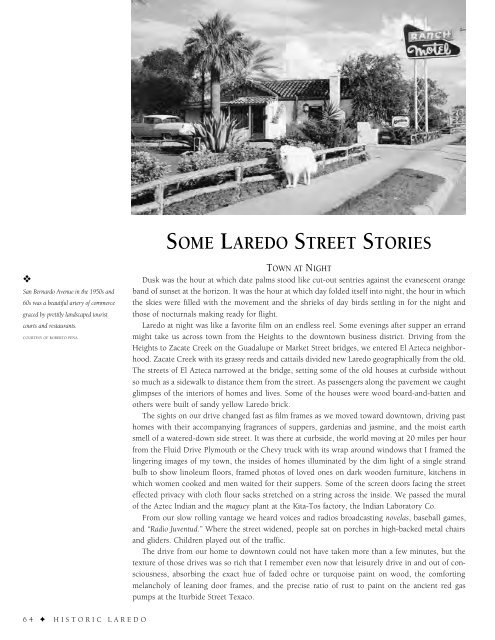Historic Laredo
An illustrated history of the city of Laredo and the Webb County area, paired with the histories of companies, families and organizations that make the region great.
An illustrated history of the city of Laredo and the Webb County area, paired with the histories of companies, families and organizations that make the region great.
You also want an ePaper? Increase the reach of your titles
YUMPU automatically turns print PDFs into web optimized ePapers that Google loves.
SOME LAREDO STREET STORIES<br />
❖<br />
San Bernardo Avenue in the 1950s and<br />
60s was a beautiful artery of commerce<br />
graced by prettily landscaped tourist<br />
courts and restaurants.<br />
COURTESY OF ROBERTO PEÑA<br />
TOWN AT NIGHT<br />
Dusk was the hour at which date palms stood like cut-out sentries against the evanescent orange<br />
band of sunset at the horizon. It was the hour at which day folded itself into night, the hour in which<br />
the skies were filled with the movement and the shrieks of day birds settling in for the night and<br />
those of nocturnals making ready for flight.<br />
<strong>Laredo</strong> at night was like a favorite film on an endless reel. Some evenings after supper an errand<br />
might take us across town from the Heights to the downtown business district. Driving from the<br />
Heights to Zacate Creek on the Guadalupe or Market Street bridges, we entered El Azteca neighborhood.<br />
Zacate Creek with its grassy reeds and cattails divided new <strong>Laredo</strong> geographically from the old.<br />
The streets of El Azteca narrowed at the bridge, setting some of the old houses at curbside without<br />
so much as a sidewalk to distance them from the street. As passengers along the pavement we caught<br />
glimpses of the interiors of homes and lives. Some of the houses were wood board-and-batten and<br />
others were built of sandy yellow <strong>Laredo</strong> brick.<br />
The sights on our drive changed fast as film frames as we moved toward downtown, driving past<br />
homes with their accompanying fragrances of suppers, gardenias and jasmine, and the moist earth<br />
smell of a watered-down side street. It was there at curbside, the world moving at 20 miles per hour<br />
from the Fluid Drive Plymouth or the Chevy truck with its wrap around windows that I framed the<br />
lingering images of my town, the insides of homes illuminated by the dim light of a single strand<br />
bulb to show linoleum floors, framed photos of loved ones on dark wooden furniture, kitchens in<br />
which women cooked and men waited for their suppers. Some of the screen doors facing the street<br />
effected privacy with cloth flour sacks stretched on a string across the inside. We passed the mural<br />
of the Aztec Indian and the maguey plant at the Kita-Tos factory, the Indian Laboratory Co.<br />
From our slow rolling vantage we heard voices and radios broadcasting novelas, baseball games,<br />
and “Radio Juventud.” Where the street widened, people sat on porches in high-backed metal chairs<br />
and gliders. Children played out of the traffic.<br />
The drive from our home to downtown could not have taken more than a few minutes, but the<br />
texture of those drives was so rich that I remember even now that leisurely drive in and out of consciousness,<br />
absorbing the exact hue of faded ochre or turquoise paint on wood, the comforting<br />
melancholy of leaning door frames, and the precise ratio of rust to paint on the ancient red gas<br />
pumps at the Iturbide Street Texaco.<br />
64 ✦ HISTORIC LAREDO
















